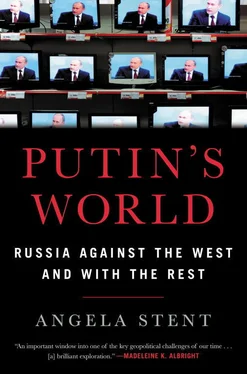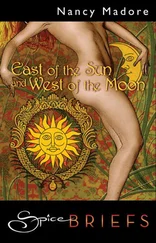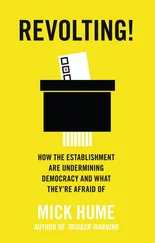THE DECISION TO ENLARGE NATO—AN EXTENSION OF CONTAINMENT?
Was the enlargement of NATO “the most fateful error of American policy in the post-Cold-War era,” as George Kennan claimed? 19The original architect of containment had changed his mind about Russia after the Soviet collapse, urging its inclusion in the European security order, warning that its exclusion would have unforeseen, dangerous consequences. In 1992, the Warsaw Pact had gone out with a whimper, and the George H. W. Bush administration faced a greatly weakened Russia and a security vacuum in Central and Eastern Europe. The Bush administration’s solution was to create the North Atlantic Cooperation Council, a NATO-led forum that included all the post-communist states. It met between 1991 and 1997 and discussed issues related to Russian troop withdrawals, but it had a large membership and diffuse agenda. In 1997, it became the Euro-Atlantic Partnership Council with fifty members. But it was soon clear that the large multilateral body with so many members, even though it met the test of inclusiveness, was not coherently planned nor did it have any real strategy. It was a temporary solution for a far more challenging issue: was it possible to create a new Euro-Atlantic security architecture in which both Russia and Eastern Europe would have a role—and a firm stake?
The countries of Central and Eastern Europe, newly liberated from Soviet control and facing daunting domestic political and economic problems, were beginning to consider the security challenges they would face in the new post-Soviet world. Meanwhile, Russia was facing even greater domestic challenges, together with adjusting to the loss of the Soviet empire. The Russian state emerged in 1992 smaller than it had been in four centuries, and without the defense perimeter provided by the other Soviet republics and the Warsaw Pact countries; it had lost the buffer states the Kremlin believed were vital for the security and safety of the Russian state—and which protected it from NATO.
In retrospect, the United States and its allies seriously underestimated what the collapse of the USSR meant for Russia’s perception of its own vulnerability, focusing rather on the insecurities and concerns of the Central European countries. Admittedly, the latter were overtly pro-Western and wanted to join NATO, while the Kremlin, still reeling from the diminution of Russia’s international clout, was much more ambivalent about the idea of joining an organization whose rules had been written by its former adversaries. The West was and remains unable to resolve the dilemma of creating a security architecture in Europe that adequately, and at the same time, addresses the concerns of Central Europe, Russia, and the Western post-Soviet states. What assuaged Central European countries’ fears heightened Russian concerns, so that NATO enlargement became a zero-sum issue, with countries like Ukraine and Georgia remaining in a no-man’s-land.
In 1993, Russia’s Foreign Intelligence Service, then led by veteran Soviet diplomat Yevgeny Primakov, put out a report warning against NATO enlargement and staked out what would become the established Russian position. “This expansion,” Primakov argued, “would bring the biggest military grouping in the world, with its colossal offensive potential, directly to the borders of Russia…. If this happens, the need will arise for a fundamental reappraisal of all defense concepts on our side, a redeployment of armed forces, and changes in operational plans…. The new Russia,” he insisted, “has a right to have its opinion taken into account.” 20
BORIS YELTSIN AND OPENING NATO’S DOOR
Perhaps more important than what was or was not said about NATO to Gorbachev in 1990 was what was said to Boris Yeltsin in 1993, just before the Primakov paper. In October 1993, shortly after Yeltsin had used deadly force to disband opposition groups in the Russian parliament, US secretary of state Warren Christopher visited Moscow to explain the idea of the Partnership for Peace. As the Clinton administration and its allies began to debate how to reorganize European security in the 1990s in such a way that gave Russia a place, it remained committed to retaining NATO. While many Russians and some in the West advocated scrapping the organization as a Cold War relic and replacing it with a pan-European organization that included Russia, Washington, and Brussels, others saw no reason to dissolve a successful alliance in which all members had a stake. And despite Russian complaints, Russia never proposed any positive agenda for redesigning European security architecture. NATO instead decided to create the Partnership for Peace (PfP), a bilateral outreach program for former Warsaw Pact countries focusing on defense and military cooperation and on the democratization of post-communist armed forces. Each country would develop its own program with NATO for PfP, and for some it could become the first step on the path to eventual membership. Some US officials intended for PfP to be an alternative to NATO membership, but for many Central European countries, membership was the goal.
When Christopher explained to Yeltsin that nothing would be done to exclude Russia from “full participation in the future security of Europe,” Yeltsin approved. But then Yeltsin asked Christopher to promise him that PfP meant partnership, not membership, for the participating Central European states. Christopher assured that this was the case. “This is a brilliant idea, it is a stroke of genius,” replied Yeltsin. Subsequently, Christopher said that the United States would be “looking at the question of membership as a longer term eventuality,” but it is unclear how Yeltsin reacted to that. 21Russia signed its PfP agreement on June 22, 1994, the anniversary of Hitler’s invasion of the USSR.
But others in Moscow from the outset were much more skeptical about PfP. Its great flaw, they argued, was that it offered Russia the same deal as every other post-communist state, meaning that it did not recognize Russia’s special status as a great power. Defense Minister Pavel Grachev declared that if Russia were to join PfP, it should have a special role and special relations with NATO. But, he was told, that kind of deal was not on. Russia would sign its PfP agreement on the same basis as everyone else. Two US ambassadors—James Collins and Thomas Pickering—later admitted that Washington reneged on its promises by subsequently offering membership to Central Europe. 22Yeltsin was correct in believing that explicit promises made in 1993 about NATO not enlarging for the foreseeable future were broken when the Clinton administration decided to offer membership to Central Europe.
Russia had barely absorbed the implications of PfP when the debate about European security leapt forward to planning NATO enlargement. The United States government was divided on this issue, as were the governments of other NATO countries. It is important to remember the context in which these debates took place. The former Warsaw Pact countries were undergoing a painful and contentious transition away from communism. The ghosts of the interwar authoritarian past of most of these countries continued to haunt them. Nativist nationalist parties, seeking to revive their ethnic agendas from the interwar years, were challenging the new democratic parties. There were several unresolved territorial disputes—for instance, between Romania and Hungary—and irredentist groups were agitating to resolve them on their terms. US and Western European officials feared that without effective structures to combat these movements, the European order could once again be threatened. EU membership was a long way off, and NATO, by imposing strict conditionality—including the resolution of territorial disputes—could serve as a democratizing instrument. Faced with the dilemma of reconciling two contradictory goals—integrating Central Europe into NATO to enhance European security and reassuring Russia that it too had a role to play in expanded Euro-Atlantic structures—the West chose to prioritize the first. Not surprisingly, while Washington told Russia that this was a win-win solution, Moscow viewed NATO enlargement in zero-sum terms. 23
Читать дальше












